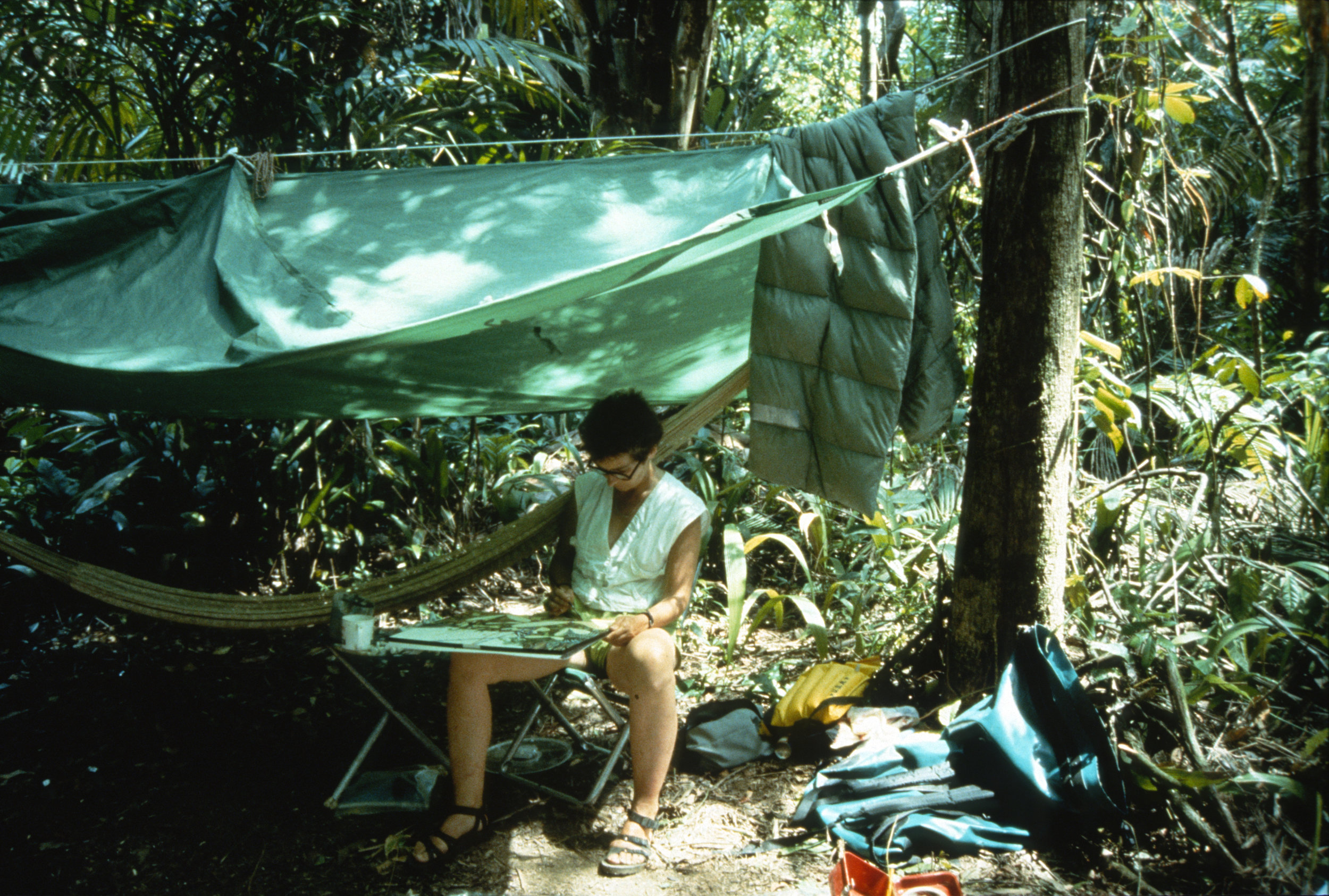Suzan Pitt
Joy Street
Opening reception:
Sunday March 31, 4-7pm
On view:
March 31 - May 5 2019
5513 W Pico Blvd. Los Angeles CA 90019
Hunter Shaw Fine Art is pleased to announce Suzan Pitt : Joy Street. The exhibition will feature a continual loop of the artist’s hand-painted animation masterpiece Joy Street (1995), presented here in a newly-produced archival edition, alongside a selection of related works on paper. Battling a period of depression in the late 1980s, Suzan Pitt utilized a Fulbright Grant to visit the remote, unspoiled rainforests of Central America, painting the region’s vibrant biodiversity and healing emotionally through immersion in nature. Trekking deep within the tropical forests of Mexico and Guatemala, Pitt worked en plein air from her inflatable kayak, producing a series of intimate and expressive watercolors of the virgin jungle, exhibited here for the first time. This regenerative experience directly inspired Joy Street, and over the next five years the artist painstakingly animated what would become a profound story of spiritual renewal through contact with nature - within the film’s narrative and her own life.
Suzan Pitt painting the jungle of Río Sarstún, Guatemala, 1989
Ironically, Joy Street begins in despair. Set to the downtrodden chords of a ragged and forlorn jazz melody, the film’s opening sequence introduces a suicidally depressed woman suffering conditions of urban isolation and emotional torment. Drinking and smoking alone in her drab, cavernous apartment, her melancholy festers into agony. Eventually, she passes out after a disturbing scene of self-harm with a cactus. At this point, the film undergoes a series of sudden mood swings when a cartoon mouse on a ceramic ashtray comes alive in the next room. Charged with bright optimism, the colorful, happy-go-lucky spirit comically dances and flops around, enlivening the bleak apartment. Accidentally stumbling upon the unconscious and bleeding woman, the mouse becomes fearful and cries for her. The dreadful atmosphere of the bedroom mutates into a vision of fetid waters polluted with human and animal corpses, broken and bloodied trees. In response to the terrible vision, the mouse carries the woman’s body to a nearby park, which magically transforms into a tropical forest bursting with life. The woman is brought to her senses by a dazzling, joyous ballet of howler monkeys, flirtatious butterflies, and hungry ants harmoniously enjoying the dense, vibrant jungle. This visually delicious sequence ends with a meditative ape delicately sniffing a rose, his eyes rolling back in peaceful pleasure over and over. When the woman awakens, back in her bed, she grins fondly as the cartoon mouse fades from view - his work complete, her spirit and consciousness restored. With effort, she pries open her dirty bedroom window, letting in sunshine and bird songs on the morning breeze - a newfound curiosity for the outside world visible on her smiling face.
Joy Street is a tremendous achievement of visual and musical storytelling. Accentuated by a brilliantly versatile score from Roy Nathanson’s Jazz Passengers featuring Debbie Harry, the film’s music and imagery deftly convey complex content without the use of dialog or text. Free from language, its message is universally accessible. Throughout the film, Pitt’s formal decisions regarding materials, style and color clearly communicate the emotional and intellectual qualities of the story. The woman and her world are rendered in a harsh, sickly manner reminiscent of the extreme angles, foreboding architecture, and romanticized dread of German Expressionism. The arrival of the mouse brings in a colorful, zany animism. The world becomes infused with spirit and character: the radio grins as the wood grain on a shelf turns into a flowing, flowering stream. On a deeper level, the ashtray mouse is in fact a talisman or fetish - a manmade object imbued with magical qualities, in this case the innocence and creativity of nature. The mouse represents the animist worldview of early cartoons in which objects, buildings and landscapes wriggle and pulsate with life, and is therefore a spiritual conduit for the woman to reconnect with nature.
In a 2008 statement on Joy Street, Pitt speaks to her inspiration for the dynamic between the depressed woman and her exuberant shamanic guide: “My son had given me a tiny ceramic ashtray, probably from the 1940s, with a little generic mouse sitting on it. I thought about how there must be something very pure in the essence of life - uncorrupted - existing in pure color, like the colors of the mouse and the innocence of the childlike nature of the cartoon. We were all becoming aware in the 90s of how we have polluted the earth and how nature has fallen to our greed and exploitation. I made the storyboard very simply about two opposites - the woman who is depressed, neurotic and spiritually bankrupt and the cartoon mouse. One forever hopeful and creative and the other mired in a sense of futility. So the film is about manic depression in one way, and in another way it is about our need to apply creative and passionate thinking to the dilemma of the natural world.”
Nearly twenty-five years since its release, Joy Street’s message of compassion towards other beings is now more urgent than ever. Widely regarded as a classic of independent animation, Joy Street is an artwork of world-class execution and worldwide significance. It is truly the work of an auteur and undoubtedly the magnum opus of Suzan Pitt’s distinguished career.
Suzan Pitt was born in Kansas City in 1943. In 1965, she received a BFA in painting from Cranbrook Academy of Art. Her film Asparagus premiered in an installation at the Whitney Museum of American Art in 1979, and was paired for two years with David Lynch’s ERASERHEAD in the notorious midnight shows at the Waverly Theater in New York City and the NuArt in Los Angeles. A retrospective of Suzan Pitt’s prize-winning animated films was presented in 2017 at the Museum of Modern Art in New York. One person exhibitions of her paintings have been presented at The Ginza Art Space in Tokyo, The Whitney Museum of American Art, Holly Solomon Gallery NY, Cantor-Lemberg Gallery Detroit, Hans Mayer Gallery Dusseldorf, and the Delahunty Gallery NY amongst many others. Her paintings and films are in the permanent collections of the Walker Art Center, The Museum of Modern Art, The Stedelijk Museum Amsterdam and the Academy of Motion Picture Arts and Sciences Los Angeles. Her animated films have been featured at hundreds of prestigious venues around the world, including the Sundance Film Festival, The New York Film Festival, The London Film Festival, the Ottawa International Animated Film Festival, Morelia International Film Festival, and the Image Forum Film Festival in Tokyo. The artist now lives and and works in Taos, NM.
Suzan Pitt with Keith Haring, wearing jackets painted by Suzan, NYC, 1980s




